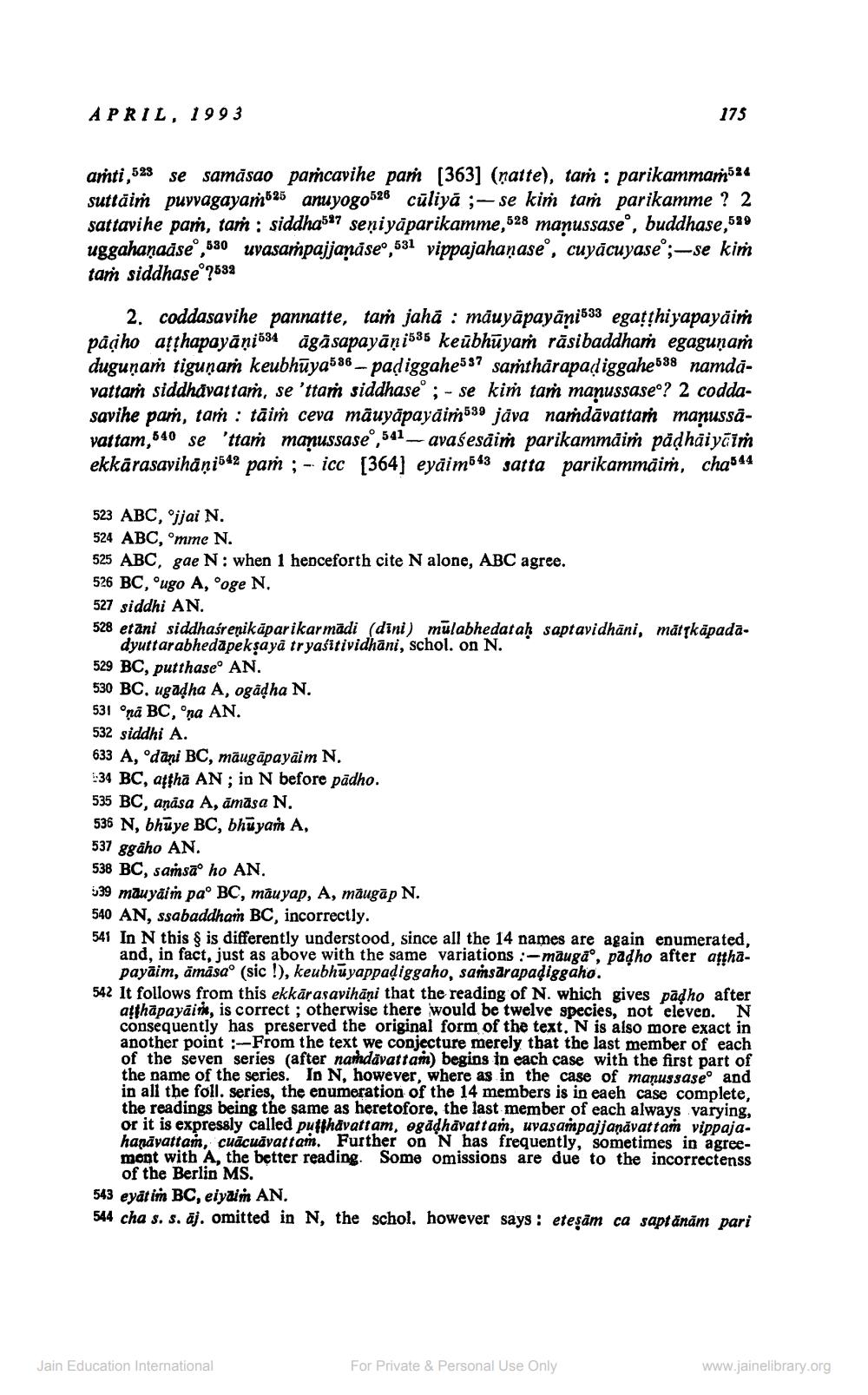________________
APRIL, 1993
175
aṁti, 528 se samāsao pańcavihe paṁ (363] (natte), taṁ : parikammar524
uttaim puvvagayam625 anuyog0526 cūliya ;- se kim taṁ parikamme ? 2 sattavihe par, tam ; siddha547 seņiyāparikamme, 528 manussase", buddhase,529 uggahanadse°,580 uvasampajjanāse0,531 vippajahaņase”, cuyācuyase'; -se kim tam siddhase® 7532
2. coddasavihe pannatte, taṁ jahā : màuyāpayāni533 egatshiyapayāim påşho ațịhapayāņi634 ăgăsapayāņi586 keūbhūyar rāsibaddham egagunań dugunaṁ tiguņam keubhūya586 - padiggahe587 saṁtharapadiggahe538 namdavattaṁ siddhavattam, se 'ttam siddhase; - se kim tam manussaseo? 2 coddasavihe par, taṁ : tāiṁ ceva māuyāpayaiṁ539 jāva nardāvattar manussavattam,540 se 'ttam manussase ,541 - avasesäiṁ parikammaiṁ padhaiyai ekkārasavihāņi542 paṁ ; - icc (364) eyaim543 satta parikammăim, cha544
523 ABC, Rjjai N. 524 ABC, omme N. 525 ABC, gae N: when 1 henceforth cite N alone, ABC agree. 526 BC, °ugo A, Roge N. 527 siddhi AN. 528 etani siddhasrenikāparikarmādi (dini) mulabhedatah saptavidhāni, mātkāpada.
dyuttarabhedapek sayā tryasitividhani, schol. on N. 529 BC, putthaseo AN. 530 BC, ugadha A, ogādha N. 531 onā BC, ona AN. 532 siddhi A. 633 A, odani BC, mõugāpayāim N. 1:34 BC, ațfha AN; in N before pādho. 535 BC, anasa A, amāsa N. 536 N, bhūye BC, bhūyaḥ A, 537 ggaho AN. 538 BC, samsão ho AN. 539 mauyaim pao BC, mâuyap, A, mäugāp N. 540 AN, ssabaddham BC, incorrectly. 541 In N this $ is differently understood, since all the 14 names are again enumerated,
and, in fact, just as above with the same variations :-maugao, padho after aftha
payāim, āmāsao (sic!), keubhuyappadiggaho, saħsarapadiggaho. 542 It follows from this ekkārasavihāni that the reading of N. which gives pādho after
atthāpaväirk, is correct; otherwise there would be twelve species, not eleven. N consequently has preserved the original form of the text. N is also more exact in another point From the text we conjecture merely that the last member of each of the seven series (after nathdävattam begins in each case with the first part of the name of the series. In N, however, where as in the case of manussase and in all the foll. series, the enumeration of the 14 members is in each case complete, the readings being the same as heretofore, the last member of each always varying, or it is expressly called pufthavattam, egădhavattam, uvasampajjanăvattan vippaja. hanāyattan, cuācuävattam. Further on N has frequently, sometimes in agreemont with A, the better reading. Some omissions are due to the incorrectenss
of the Berlin MS. 543 eyat in BC, eiyain AN, 544 cha s. s. dj. omitted in N, the schol. however says : eteşām ca saptānām pari
Jain Education International
For Private & Personal Use Only
www.jainelibrary.org




